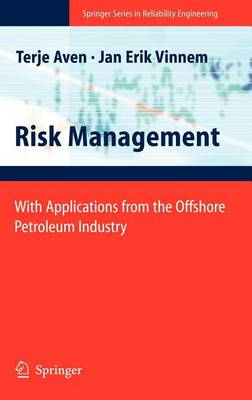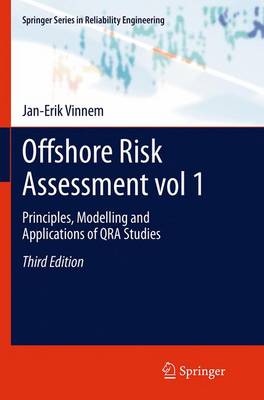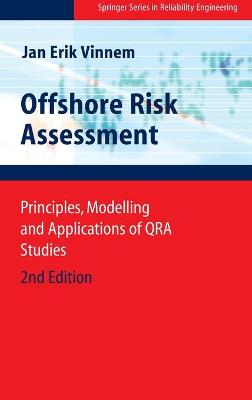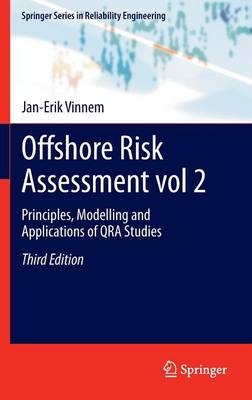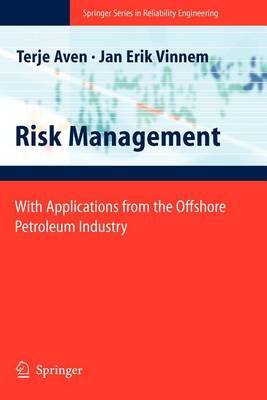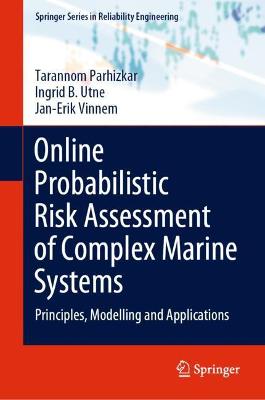Springer Series in Reliability Engineering
6 total works
Risk Management: With Applications from the Offshore Petroleum Industry
by Professor Terje Aven and Jan Erik Vinnem
Offshore Risk Assessment was the first book to deal with quantified risk assessment (QRA) as applied specifically to offshore installations and operations. Risk assessment techniques have been used for more than three decades in the offshore oil and gas industry, and their use is set to expand increasingly as the industry moves into new areas and faces new challenges in older regions.
This updated and expanded third edition has been informed by a major R&D program on offshore risk assessment in Norway and summarizes research from 2006 to the present day. Rooted with a thorough discussion of risk metrics and risk analysis methodology, subsequent chapters are devoted to analytical approaches to escalation, escape, evacuation and rescue analysis of safety and emergency systems.
Separate chapters analyze the main hazards of offshore structures: fire, explosion, collision, and falling objects as well as structural and marine hazards. Risk mitigation and control are discussed, as well as an illustration of how the results from quantitative risk assessment studies should be presented. The third second edition has a stronger focus on the use of risk assessment techniques in the operation of offshore installations. Also decommissioning of installations is covered.
Not only does Offshore Risk Assessment describe the state of the art of QRA, it also identifies weaknesses and areas that need further development. This new edition also illustrates applications or quantitative risk analysis methodology to offshore petroleum applications.
A comprehensive reference for academics and students of marine/offshore risk assessment and management, the book should also be owned by professionals in the industry, contractors, suppliers, consultants and regulatory authorities.
Offshore Risk Assessment was the first book to deal with quantified risk assessment (QRA) as applied specifically to offshore installations and operations. This book is a major revision of the first edition. It has been informed by a major R&D programme on offshore risk assessment in Norway (2002-2006). Not only does this book describe the state-of-the-art of QRA, it also identifies weaknesses and areas that need development.
Offshore Risk Assessment was the first book to deal with quantified risk assessment (QRA) as applied specifically to offshore installations and operations. Risk assessment techniques have been used for more than three decades in the offshore oil and gas industry, and their use is set to expand increasingly as the industry moves into new areas and faces new challenges in older regions.
This updated and expanded third edition has been informed by a major R&D program on offshore risk assessment in Norway and summarizes research from 2006 to the present day. Rooted with a thorough discussion of risk metrics and risk analysis methodology, subsequent chapters are devoted to analytical approaches to escalation, escape, evacuation and rescue analysis of safety and emergency systems.
Separate chapters analyze the main hazards of offshore structures: fire, explosion, collision, and falling objects as well as structural and marine hazards. Risk mitigation and control are discussed, as well as an illustration of how the results from quantitative risk assessment studies should be presented. The third second edition has a stronger focus on the use of risk assessment techniques in the operation of offshore installations. Also decommissioning of installations is covered.
Not only does Offshore Risk Assessment describe the state of the art of QRA, it also identifies weaknesses and areas that need further development. This new edition also illustrates applications or quantitative risk analysis methodology to offshore petroleum applications.
A comprehensive reference for academics and students of marine/offshore risk assessment and management, the book should also be owned by professionals in the industry, contractors, suppliers, consultants and regulatory authorities.
This book presents a risk management framework designed to achieve better decisions and more desirable outcomes. It presents an in-depth discussion of some fundamental principles of risk management related to the use of expected values, uncertainty handling, and risk acceptance criteria. Several examples from the offshore petroleum industry are included to illustrate the use of the framework, but it can also be applied in other areas.
Online Probabilistic Risk Assessment of Complex Marine Systems
by Tarannom Parhizkar, Ingrid B Utne, and Jan Erik Vinnem
This book proposes a new approach to dynamic and online risk assessment of automated and autonomous marine systems, taking into account different environmental and operational conditions. The book presents lessons learnt from dynamic positioning incidents and accidents, and discusses the challenges of risk assessment of complex systems.
The book begins by introducing dynamic and online risk assessment, before presenting automated and autonomous marine systems, as well as numerous dynamic positioning incidents. It then discusses human interactions with technology and explores how to quantify human error. Dynamic probabilistic risk assessment and online risk assessment are both considered fully, including case studies with the application of assisting operators in decision making in emergency situations. Finally, areas for future research are suggested.
This practical volume offers tools and methodologies to help operators make better decisions and improve the safety of automated and autonomous marine systems. It provides a guideline for researchers and practitioners to perform dynamic probabilistic and online risk assessment, which also should be applicable to other complex systems outside the marine and maritime domain, such as nuclear power plants, chemical processes, autonomous transport systems, and space shuttles.
